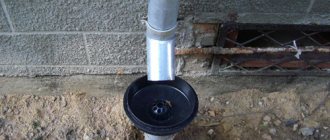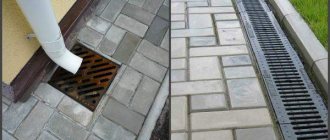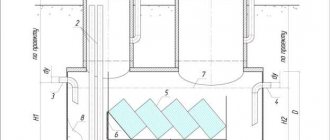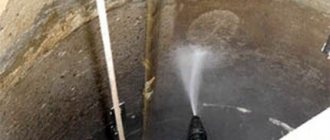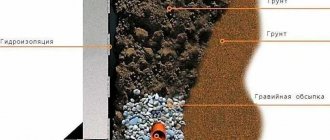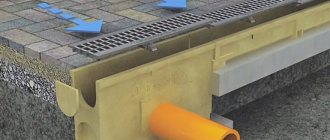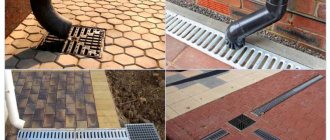Home > Articles > Storm sewer > Storm sewer repair
- Ask a Question
- Send a request
Storm sewer repair most often involves replacing its individual elements that have failed. If there are problems with the surface drainage system, it needs to be repaired as quickly as possible: even a small leak or blockage can quickly lead to flooding of the area.
Drainage defects: types and factors of their formation
The drainage system of a house is exposed to all natural stresses. And this does not remain without consequences. But among the reasons that lead to repair of roof gutters, there are others. Let's consider each defect separately and outline the methods and methods of elimination.
Installation error
Unfortunately, many Internet portals are full of messages that installing a drainage system yourself is not a problem. Despite the apparent simplicity of the drainage design, it is actually a complex system. Firstly, it is gravity-flowing, which means there are certain requirements for the inclination of its horizontal part. Secondly, an important point is competently carried out fasteners, on which the strength of the entire structure depends.
As for the first position. The mistake many owners make when installing gutters themselves is that they install the system’s gutters at the wrong angle. Or they simply display it incorrectly. And the slope value should vary in the range of 3-7°. That is, the difference in the installation height of one end of the gutter and the opposite should be 3-7 m per 1 m of the length of the horizontal part.
How to determine the angle of inclination of the guttered part of a roof drainage system Source strbuild.ru
For example, if the length of the cornice, and accordingly the tray part of the drain, is 10 m, then the difference in the height of the above-installed end above the lower-installed one should be 3-7 cm. Sometimes home craftsmen do not succeed in this, which means that the water that gets into the trays will be either flow down gutters slowly, causing blockages, or too quickly, overflowing the sides.
How to fix this defect:
- First of all, you will have to disassemble the tray part of the drainage system completely.
- Then decide on the location of the upper end of the tray .
- Here they install, at a distance of 30 cm from the edge of the cornice along the overhang, a bracket to support the gutter .
- A strong thread is tied to the attached bracket .
- The thread is pulled horizontally, and a mark is placed .
- From the last one, a size from the range of 3-7 cm is lowered down. The same second extreme bracket is attached to this place.
- The thread is tied to it.
- Intermediate brackets are installed along a stretched twine in 60 cm increments .
- Gutters are already installed on them .
Scheme for replacing a defective grooved part with a new one Source tincraft.com.ua
Regarding fasteners. There are usually no problems with vertical drainpipes. They are secured using plastic clamps, which are attached to the walls of the house with self-tapping screws and plastic dowels. The main task of the work manufacturer is to strictly adhere to the clamp installation step, which varies between 1.8-2.0 m. Please note that if the length of the vertical drainage elements exceeds 10 m, then the clamp installation step is reduced to 1.5 m.
It is more difficult to attach the brackets under the grooved part. It all depends on what kind of structure is used to construct the roof. The easiest option for repairing a drainage system is when the brackets are attached to the front board. For example, if the mounting point were the rafter legs, or rather their upper horizontal ends, then the roofing material that covers the overhang would have to be lifted. If there were side ends, then the soffits would have to be disassembled.
How to attach the brackets of the grooved part of the drain to the frontal board Source krovlyakryshi.ru
And another mistake of incorrect installation. There is a strict requirement that the gutters be installed relative to the edge of the roofing material. The latter should be located relative to the trays within 1/3 of their width. In this way, the exact flow of water into the tray part is achieved.
Fixing such a defect is not easy. To do this, you will have to either pull the brackets outward or recess them inside the rafter system. If the latter were installed on the frontal board, then shims will have to be installed under them. If, on the contrary, you need to make the gap smaller, then there is only one way out - change the brackets to devices with a smaller protrusion.
Water must accurately fall into the drainage system trays Source sam-postroj.su
Calculation error
Sometimes a gutter system kit is bought by eye. That is, they take the average diameters of vertical pipes and horizontal trays. And this is the wrong approach. Because both parameters must be purchased in accordance with the area of the slopes of the roofing structure, from which water from precipitation will be collected. And the larger the area of the slope, the larger the diameters of the elements of the drainage structure should be. Here the dependency is:
| Roof slope area, m² | Vertical pipe diameter, m | Gutter diameter, m |
| 70 | 75 | 100 |
| 70-120 | 90 | 125 |
| 120-150 | 100 | 150 |
| 150-200 | 120 | 200 |
And one moment. Table values must be used if one vertical riser is installed on the slope. Usually it is sufficient if the length of the roof eaves does not exceed 24 m. If possible, it is better to install two pipe risers, the distance between which should not exceed 12 m.
One riser is enough if the length of the cornice does not exceed 24 m Source yellowpages.com
Mechanical damage
During long-term operation or if damaged by ice that formed during the freezing process of water, elements of the drainage system may crack or burst. Failed gutters, pipes, funnels and fittings cannot be restored. That is, repairing a drain on the roof of a private house develops into a complete replacement of these elements.
How to replace a gutter. Trays are usually simply laid on brackets and attached to them in various ways. So the first thing you need to do is understand the fastening system. And then try to loosen this fastening. After which the defective gutter is removed, and a new one, chosen exactly in size and color, is installed in its place.
The joints of the trays must be treated with silicone sealant to increase the tightness of the connecting areas. Check the installation for the slope of the horizontal part of the drain. Then the fastening is carried out.
In principle, the pipes of vertical risers must be replaced in the same way. There is no need to remove clamps from the walls. They simply open in the defective area, pipes are pulled out from the inside and replaced with new ones. Installation is carried out in reverse order.
Problems with fasteners ↑
During operation of the roof drainage system, the greatest load is experienced by the fastening elements. According to the technology, they should be located for gutters at a maximum distance from each other of 60 cm, and for pipes - 300 cm. In this way, the likelihood of their deformation or loosening can be reduced
It is also important to choose the correct fastening configuration - its strength and durability depend on this
To replace, you must first identify the defective element. Most often, the main sign of a breakdown is an increased noise level - the gutter or pipe moves against the fasteners as water drains. Having examined the location of the defect, you need to find out the reason for its appearance.
If there is no visible damage, most likely the cause of the noise is loose fasteners. To eliminate it, you need to tighten the screws and self-tapping screws more tightly. If deformation is detected, the mounting hook (clamp) must be completely replaced. To do this, use a screwdriver or screwdriver to unscrew the screws and remove the fastening. When installing a new one, you should use screws with a larger diameter and length, since the installation will be carried out in the old holes on the face board or joists. After this, a strength check is performed and the fasteners are screwed to the gutter or downspout.
Is it possible to repair gutters yourself? This task is completely solvable if you approach it professionally. The main thing to consider is that the new elements must fully match the dimensions and performance characteristics of the ones being replaced.
2020 stylekrov.ru
Video description
The video shows how they repair a metal drain pipe riser that has simply rotted:
See also: Catalog of companies that specialize in roof repairs.
Sometimes there are small cracks that, if not repaired, can develop into large flaws. If the drain is metal, then you can try to paint over the crack with a thick layer of paint matched to the color of the drainage system. It is better to use so-called rubber paint for this.
If the drainage system is made of plastic, then the crack can be welded using two-component cold welding. Essentially, this is a special solution that is applied to the defect site. It fills the crack, preventing it from expanding and lengthening.
Mechanical damage also includes failure of fasteners. Easier with clamps.
- They need to be unfastened .
- Pull the pipe out.
- Remove the fastener by unscrewing the self-tapping screw from the dowel.
- Install the new one by screwing the screw back in.
It’s more difficult with brackets, especially those that are screwed to the rafters or sheathing. To do this, you will have to partially dismantle the roofing material. In any case, raise its edge at the eaves of the roof.
The drainage system is rotten and leaking Source in.pinterest.com
Replacing fasteners
This element bears the heaviest load during drainage operation. Fastenings for gutters should be less than 60 centimeters apart, and for downspouts less than 300 centimeters.
With this arrangement of fastenings, the likelihood of them becoming loose or deforming becomes less. The correct choice of fastener configuration also plays an important role, since this affects its durability and reliability.
When replacing, you first need to find out which element is defective. The main sign of a malfunction is the noise created by pipes or gutters when they hit the mount as precipitation flows down.
If there are no visible defects, the cause of the noise is most likely a loose fastener. In this case, you need to wrap the screws and self-tapping screws more tightly. If there is a defect, then the mounting hook must be completely replaced. For these purposes, you need to unscrew the screws and then dismantle the fasteners of the drainage system.
To fix the new fasteners, long screws with a large diameter are used, since installation is carried out in the same holes on the joists or face board. Next, check the strength and screw the mount to the pipe or gutter.
Slate roofing
Making a roof frame with your own hands
How to make a roof lining yourself
Functions of a ridge aerator for a soft roof
So that defects do not appear for a long time
What can be done to avoid repairing the drainage system in a country house, or at least delay this process. There is only one option - every autumn after the leaves fall, clean the trays and pipes from debris, fallen leaves and twigs.
This can be done with your hands, scrapers or a broom. Companies that offer drain repair and cleaning services usually use a hydraulic method, which involves using pressurized water by installing a pump and a water tank.
In order not to waste time and money on this, it is better to install a grid or mesh made of a polymer composition in the tray part. The photo below shows how easy this can be done.
Protective mesh inside the gutter
Sewerage service
Sewerage service involves performing the following work:
- periodic inspection of inspection wells, open trays, etc.;
- preventive flushing of external pipelines, trays, collectors, etc. using a hydrodynamic method;
- preventive cleaning of the internal sewer network with mobile hydrodynamic and electromechanical devices;
- periodic pumping of inspection wells, grease traps, settling tanks, sand and oil traps, etc.
If there is a suspicion of abnormal network operation, in case of accidents and the impossibility of eliminating the blockage using standard procedures, we perform video diagnostics by agreement.
Repair of internal drainage
An internal drain is one part of vertically installed pipes that penetrate a private house from the roof to the basement. They try to hide the pipes in the walls, so the pipes rarely crack or burst, because the temperature is always positive.
Usually the funnel that is installed on the surface of a flat roof fails. It is simply replaced with a new one. But this is associated with a rather complex repair process affecting the roofing material of the roof. Because the coating, which is a bitumen-based roll roofing, must cover the funnel fields. That is, replacing the latter means opening a section of roofing material. This must be done carefully so as not to break the tightness of the coating.
It is impossible to repair the drainage system from the inside if the pipes are embedded in the walls. If they are carried out separately from the supporting structures, then the repair is carried out in exactly the same way as in the case of pipe risers of the external drainage system. That is, replacing failed ones with new ones. The pipes are assembled using the socket method, so dismantling the defective section and installing a new one is easy.
Replacing an internal drain on a flat roof
Installation of a new pipe ↑
Vertical drainpipes are designed to drain atmospheric precipitation from receiving funnels and gutters. The greatest danger is posed by large volumes of water and accumulated debris. Also, in the absence of a heating system, there is a high probability of the formation of ice plugs, which not only prevent the drainage of liquid, but also significantly increase the load on the pipe walls.
The most common defect of this drainage element is the appearance of cracks due to strong mechanical stress. The procedure for replacing a pipe is similar to the same procedure for a gutter. The difference lies in the correct selection of diameter and model. In most cases, the connection of individual elements is carried out using socket joints. Therefore, when purchasing a new pipe, it is recommended to take a sample of the old one with you.
To perform a quality repair, it is recommended to remove the pipe, except for the upper elbow.
- Dismantling the outer arcs of the mounting clamps.
- Removing the drainpipe.
- Removing the damaged area. If the connection point is clogged or difficult to remove, you can use WD-40 (for galvanized models) or a lubricant (for plastic ones).
- Installation of a new pipe. Its size should match the old one.
After this, the entire structure is installed in its old place, the correct level of location and reliability of fastening must be checked.
Advice To prevent the occurrence of ice jams, it is recommended to install heating cables.
They are installed on the inner surface of the pipe. To select a specific model, it is necessary to perform a preliminary power calculation. This way you can replace your gutters yourself with minimal financial outlay.
Gutter repair prices
Today, a large number of companies offer services for repairing gutters on the roofs of private houses with prices that depend on the volume of operations performed and the degree of defectiveness of elements of drainage systems. From several prices:
- dismantling 1 m of system length - within 400 rubles;
- installation of a new element – 300 rubles;
- replacement of brackets – 100 rubles/piece;
- replacement of clamps – 100 rubles/piece;
- replacement of funnels and drains – 100-150 rubles/piece.
Causes and types of breakdowns
Repairing an external drain is a simple procedure and can be done with your own hands. The design of the drainage system is a system of gutters, usually installed around the perimeter of the roof, brackets, funnels and an outlet mounted on the wall of the building.
Failures of such systems often occur for the following reasons:
- Installation error. Usually we are talking about non-compliance with the slope or nuances of the installation procedure. Since the entire system is gravity-flowing, maintaining a certain angle during installation is necessary for the water to drain away. The optimal figure is 3-7 mm per linear meter of drainage. In addition, the visor should not cover the gutter by more than a third, otherwise most of the water will spill past;
- Faulty fastener. After prolonged use, the strength of the fastening may be significantly reduced, which will cause part of the gutter or pipe to hit the wall, creating noise. In addition, the fasteners themselves may initially be incorrectly selected or secured to the wall;
- Mechanical damage. Most often they occur in plastic elements of the system;
- Sagging of the drainage area. Occurs due to improper fastening;
- The occurrence of blockages. Occurs due to leaves, bird feathers and other debris entering the system.
Sewerage maintenance: frequency of sanitation
Sewerage maintenance involves periodic inspections and preventive maintenance. The frequency of their execution depends on several factors:
- quality of design and installation - in the presence of significant deficiencies, a decrease in system throughput is observed more often, i.e. the interval between cleanings should be shorter;
- the purpose of the system and operating features - for example, in the presence of fats and oil products in wastewater, faster overgrowing of the internal surfaces of pipelines is observed;
- weather conditions - with large amounts of precipitation, the amount of sand, silt and other contaminants increases significantly, which leads to clogging of storm and drainage sewer systems;
- age of the system - networks installed long ago were not designed for the load under which they are forced to function, which also leads to accelerated clogging.
On average, preventive sewer maintenance should be performed once every 6 months. The need to reduce time intervals is established based on the features listed above, as well as practical observations.
Preventive actions
Maintenance of the stormwater system is carried out both at the beginning and at the end of the operating season. Moreover, at the beginning of the season it is worth warming up the storm pipes with steam, ridding the system of ice jams. And at the end of the season, the pipes are washed with a dense stream of water and silt deposits are removed from the sand receiver.
Of course, all of the above tools can be purchased for personal use, but they are very expensive. Therefore, those who like to solve problems “with their own hands” rent the necessary equipment, paying a relatively modest amount.
Well, the prevention process itself, when trying to solve the problem “with your own hands,” looks like this:
Stormwater system prevention
- A pipe with a nozzle is inserted into the storm drain. After this, the pipe is connected to the compressor and the pressure from the nozzle begins to clean the cavity of the tray, washing away all the debris into the sand receptacle.
- After cleaning is completed, a vacuum hose is inserted into the sand receiver and connected to a pump suitable for pumping suspensions. And the sand is pumped out of the receiver cavity into some container.
Maintenance of sewerage systems
Scheduled sewerage maintenance will allow you to avoid many unpleasant breakdowns and blockages that can paralyze the work of any enterprise for a long time. Pipes gradually become overgrown with sediment, and containers become overfilled with sludge, which over time leads to blockages and damage to the pipeline. Any accident causes serious losses, so it is better to prevent it than to pay for repairs and liquidation of the consequences later. LLC "Communal Service" offers sewerage maintenance in St. Petersburg and the Leningrad region in accordance with the standards. Here you will find competitive prices and a responsible attitude.
What is included in the mandatory list of services?
- Storm sewer maintenance. Storm drains gradually become clogged with external debris, silt and sand, resulting in rain and melt water accumulating in the area. Timely cleaning of gratings and pipes will prevent erosion of foundations and ensure the efficient functioning of the system.
- Maintenance of autonomous sewerage. Septic tanks and other treatment facilities require periodic pumping of accumulated sludge, as well as cleaning of pipes. We use modern sludge suckers with long boom lengths, which are capable of emptying any tank of wastewater in the shortest possible time.
- Maintenance of local sewerage. Cleaning pipes and grates, preventing blockages, pumping out and removing sediment. The company's employees will provide maintenance of external sewerage and internal CS to prevent any malfunctions. And also eliminate possible risks of breakdowns or stagnation.
Maintenance and repair of CS is a set of works that includes not only scheduled maintenance of sewerage networks - their complete reconstruction with the installation of new equipment made from modern materials is possible. Nevaeko tanks and reservoirs are made of fiberglass, which is not afraid of corrosion and is not destroyed under the influence of aggressive substances entering the compressor station.
Many large centers and industrial organizations from St. Petersburg and the region are already our clients. Many years of experience in this field allows us to take on the most complex situations of organizing and designing a compressor system. However, timely maintenance allows you to avoid unexpected costs and breakdowns in time.
What are the benefits of contacting us?
- Affordable cost of services. The price for servicing an autonomous sewer system will be low, and small costs will help prevent serious expenses in the future.
- Excellent technical equipment. Procedures for cleaning paths and pumping out sludge are carried out using the best modern equipment. They will be completed quickly, rest assured, you will not have any complaints about the quality.
- Convenient schedule. It is possible to conclude an agreement on the frequency of work on sewer networks. You choose the time yourself, so maintaining communications in good condition will not cause any inconvenience.
Since 2009, our company has been servicing sewerage systems in St. Petersburg and Leningrad Region, installing specialized equipment, carrying out preventive complexes, preparing and implementing construction projects, and much more. We are professionals and guarantee you an individual approach and a responsible attitude to business. Find out more by calling us and sign a contract!

